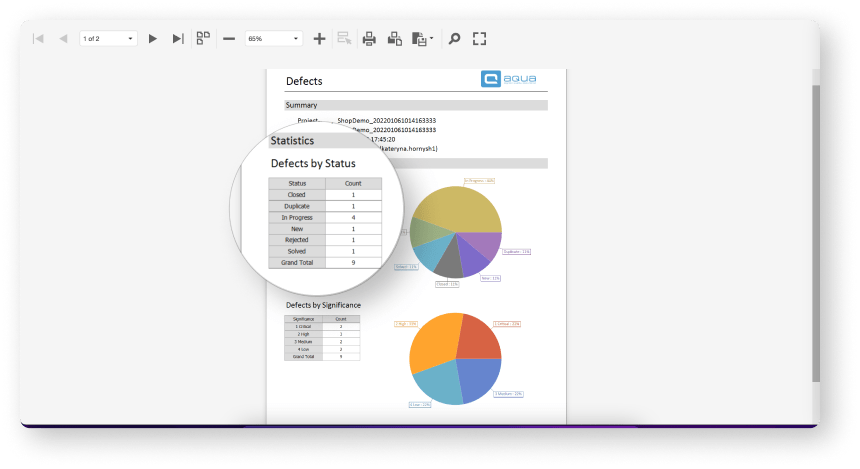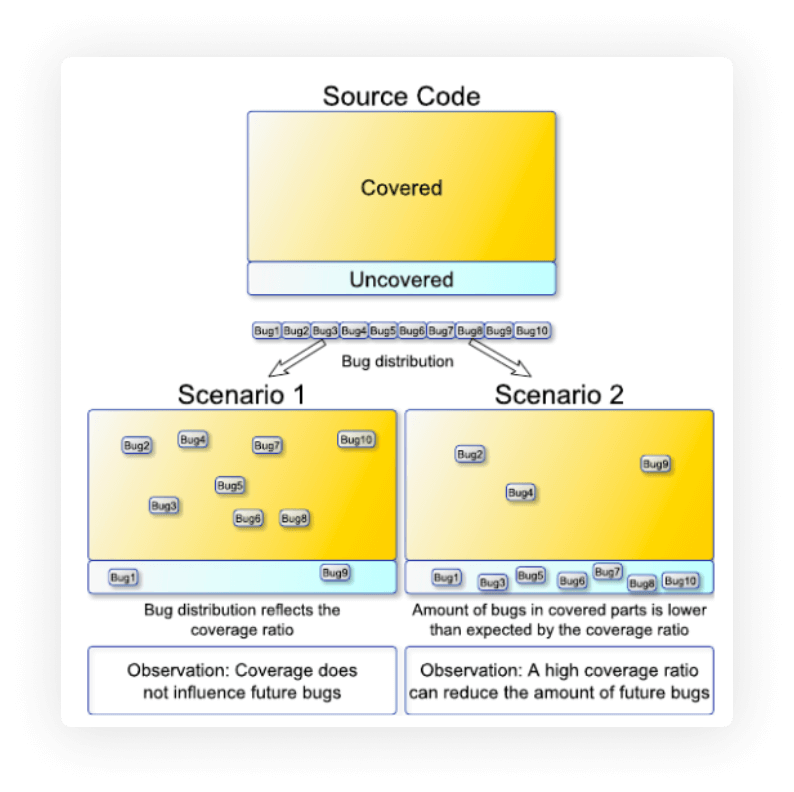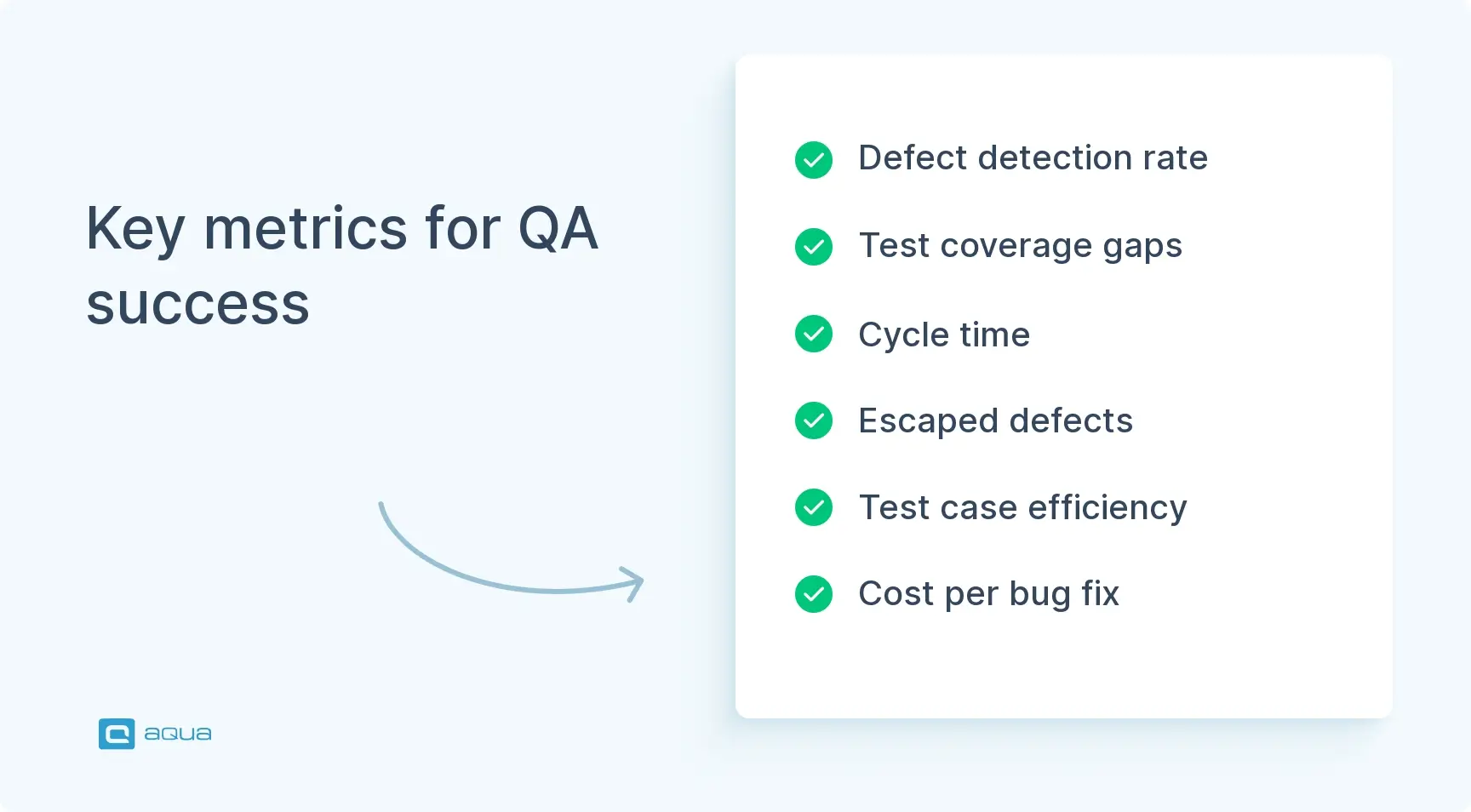In the world of development, there is an undying rule that you can’t improve what you can’t measure. And of course, this rule applies to quality assurance.
The arrays of produced software are growing exponentially, which means that the amount of test coverage required to guarantee quality is increasing to the same extent. Which also leads to that kind of causal relationship — more lines of code, more defects. So, in addition, to prepare the QA team for test automation and optimisation, you also need to think about implementing an effective bug reporting tool.
However, even with an effective web-based test case management tool in place, it is necessary to understand what progress metrics in software testing need to be applied in order to get a clearer picture of the efficient efforts of quality assurance. You’ll want to focus on the QA metrics that actually move the needle—defect detection rates, cycle time, and test coverage gaps that agile teams often miss. But here’s the thing: tracking escaped defects per sprint can nearly double your team’s reliability within weeks. Start by measuring how many bugs slip past your current process into production, then work backward to identify the testing blind spots.
If you’re eager to delve deeper into this subject, we highly recommend checking out our video for additional information.
How to understand what Quality Assurance metrics to use
The correct understanding of KPI metrics in software testing can eliminate “the future is uncertain, and the end is always near”.
What does this quote of the Doors mean for the product? It means that the better you know what to measure, the better chance your product will end up in your clients’ hands but not in a trash can of angry investors.
Before you start evaluating your own testing process, you need to determine what specific types of metrics in software testing you might need for this.
The correct solution here is to make sure you have the answers to the following questions:
1
How long will it take to test?
2
How much will it cost to test?
3
Is it reasonable to use low-cost tests?
4
What is the severity of the bugs?
5
What is the status of each bug — closed, reopened, postponed?
6
How many bugs have to be discovered in perspective?
7
How much of the software is tested?
8
Can tests be run on specified time frames and is it possible to fit more in the same time period?
9
Will it require more test efforts?
Once the questions are answered you can go further and choose QA testing metrics that can meet your requirements. However, you should remember that metrics are not universal — different businesses need different metrics and measurement in software testing. So, we recommend you learn more about aqua cloud reporting features and explore Report wizard.
So, there are some tools that you can use to identify such metrics. We recommend you learn more about aqua cloud and its reporting features and explore Report wizard.

aqua cloud report with examples of metrics & available report formats
The Report wizard’s functionality can help you identify which criteria are important for your business. It is possible to display different scenarios of your reporting, compare different data types in the same report or create two separate reports and compare which one meets your needs.
You need a strong ally to optimise all your QA metrics, and aqua cloud is the ultimate solution for your entire journey. Featuring one of the most robust reporting modules among Test Management Systems (TMS), aqua empowers you to build highly flexible reports and dashboards tailored to your needs. Whether you need detailed insights into test case management, bug tracking, or comprehensive metrics like testing time, cost, bug severity, and test coverage, aqua provides the tools to enhance visibility and decision-making.
Beyond its powerful reporting capabilities, aqua offers a comprehensive TMS solution designed to streamline testing processes. Bringing German quality to your testing efforts, aqua ensures testing is faster and more focused. With aqua cloud, you can prioritise data-driven decisions and achieve optimal software quality efficiently.
Best Practices for Choosing and Using QA Metrics
Picking the right QA metrics is all about measuring what actually moves the needle. If you align your metrics with specific business goals, you might see nearly double the improvement in quality outcomes.
Start with this concrete first step: pick three metrics max and give each one a clear purpose. Ask yourself, ‘What decision will this help me make?’ If you can’t answer that quickly, ditch it. Get your team involved in monthly metric reviews—when everyone understands not just what you’re tracking but why, adoption shoots up significantly.
Note: don’t lean on a single metric like test coverage or defect count. Balance process measures (how you work), product measures (what you build), and project measures (when you deliver). This creates a much clearer picture than any single number ever could.
Make your data visible through simple dashboards, but here’s the non-obvious part—focus on trends over time rather than individual data points. A spike in bugs might look alarming, but if your detection rate is improving week over week, you’re winning. Keep reviewing and adjusting your metrics as projects shift—what worked for last quarter’s release might not fit this quarter’s goals.
With aqua’s intuitive interface and advanced capabilities, QA engineers can focus on:
- Painless test planning and execution
- Defect management
- Automation frameworks
Meanwhile, managers benefit from:
- A 100% transparent and traceable system
- Workflow customisation
- Instant data for decision-making
Ready to revolutionise your QA efforts? Try aqua to take away the pain of testing for good!
Achieve 100% transparency and traceability with an AI-powered solution
QA effectiveness metrics
Absolute Numbers:
Absolute metrics are a great way to get a general idea of how the current testing processes are built. And their presence is recommended for all types of development.
- Total number of test cases
- Number of test cases passed
- Number of test cases failed
- Number of test cases blocked
- Number of defects found
- Number of defects accepted
- Number of defects rejected
- Number of defects deferred
- Number of critical defects
- Number of planned test hours
- Number of actual test hours
- Number of bugs found after shipping
Test Execution and Bug Fixing
Test metrics in software testing showing the correlation between completed tasks from the total number of functions allow the whole team to understand which errors in which modules disrupt the product and should be addressed primarily:
Test Design
Test design coverage evaluates the correlation between test cases and the number of requirements, while test design performance evaluates the number of test cases generated per day. It is done to find out gaps in functionality on the end-user side:
Test Coverage
Test coverage evaluates test effort and gives the idea of what percentage of the application has been already tested.
User Acceptance Testing
This metric is supposed to discover missed issues that might occur due to gaps in the testing strategy:
Product Exploitation and Support
This metric is used for strategy improvements to boost testing performance. It also evaluates testing effectiveness by showing the number of undiscovered issues that need to be addressed before production deployment:
Test Economics Metrics
The cost of testing consists of infrastructure, tools and workforce. This metric evaluates how much needs to be spent to finish the project and how much is actually spent:
Test Execution Status
This metric is better to be represented in a chart to display the total executions organised as passed, failed, blocked, incomplete, and unexecuted.
Defects Created vs. Defects Resolved Chart
This metric is supposed to control defect removal processes and understand testing effectiveness metrics.
Overall Metrics
Overall testing metrics measure the effectiveness of your test strategy in general identifying needed improvements:
Test Reliability
It’s always nice to have someone to rely on, especially if you’re a QA engineer who wants to trust your testing one hundred percent. The main criteria can be considered the issuance of non-false results to be convinced of each unsuccessful test. There is a real problem, the test is successful only in a REALLY bug-free feature, and there is no large gap between errors and tests, in other words, true correlation.
By tracking these metrics, you can identify areas for improvement, optimise testing resources, and enhance the overall quality of your software. However, managing and interpreting QA metrics can be complex, and it’s essential to have the right tools to streamline this process.
This is where aqua cloud comes in. With aqua, you can effortlessly track and analyse key QA metrics to drive continuous improvement in your testing process. aqua’s intuitive interface and advanced features make it easy to monitor test automation coverage, assess test environment stability, evaluate test case efficiency, and more. Additionally, aqua’s AI Copilot feature enhances your testing process by automating the creation of new tests and completing test drafts. By leveraging artificial intelligence, aqua helps you save time and focus on areas that require more attention and creativity.
Experience the future of QA with an AI-powered solution
Distribution of defects
The number of discovered defects can mean two things — either the testers work very well, or the testers work poorly.
Jokes aside, the Distribution of defects is a great testing measurement for a software department.

“Exemplary coverage and bug distributions. Scenario 1 describes a situation where coverage ratio is meaningless for future code quality measured by the amount of bugs. Scenario 2 shows a situation where coverage is meaningful.” © Artur Andrzejak
The number of bugs found in certain product areas can tell developers where to go. If the total number of defects found is evenly distributed on one platform, then this is more likely a general problem in development. However, developers should optimise specific environments if such a distribution is uneven.
Test automation share
Looking to nail your automation metrics? Focus on automation coverage – but here’s the thing: it’s not just about how many test cases you’ve automated.
You need to track three layers: code coverage, requirement coverage, and API endpoint coverage. Smart teams also monitor their pass rate percentage and execution speed – because what’s the point of fast tests that constantly fail?
Here’s your immediate action step: start measuring your flakiness rate this week. Tests that randomly fail eat up nearly double the maintenance time compared to stable ones.
If you’re spending more time fixing automated tests than writing new ones, you’ve hit the danger zone. Track maintenance effort as a percentage of total QA time – keep it under 20% and you’re golden.
Your automation should make life easier, not create a second full-time job of babysitting unreliable tests. This way, you will cover critical and repetitive test scenarios and will be able to focus on complex situations.
Test environment stability
Your test environment and its reliability should be a top priority when measuring your QA efforts; this is where the test environment stability comes in. Frequent environmental issues can delay testing and impact the product’s quality. Monitoring the test environment’s stability helps you identify potential bottlenecks and ensures that the environment provides a consistent and reliable platform for testing.
Test case efficiency
Being one of the most notable QA metrics in software testing, test case efficiency measures the effectiveness of individual test cases in identifying defects. A high test case efficiency suggests that the test cases are well-designed and capable of detecting faults accurately. It also helps identify ineffective test cases that may need improvement or removal.
Test data coverage
This metric evaluates the diversity and coverage of test data used during testing. Comprehensive test data coverage is vital to simulate real-world scenarios and uncover potential defects that might arise under different data conditions. It ensures the application is tested under various data sets and helps identify data-related issues.
Test cycle time
One of the most essential QA performance metrics is test cycle time, which measures the time to complete one test cycle, from planning to closure. Reducing test cycle time enhances the agility of the testing process, shortens feedback loops, and accelerates the product’s time-to-market. It also helps identify bottlenecks in the testing process and aids in continuous improvement.
Defect severity distribution
This metric categorises defects based on severity levels (e.g., critical, major, minor) and tracks the distribution over time. Understanding the distribution of defect severities allows prioritising high-severity defects for immediate attention, thus minimising the potential impact on end-users.
Test environment readiness
Test environment readiness evaluates how well the testing environment is prepared for testing activities. This includes verifying the availability of necessary tools, data, and configurations. A well-prepared test environment minimises interruptions during testing and maximises productivity.
Customer satisfaction (post-release)
Customer satisfaction measures how satisfied your end-users are with your product after release. Gathering user feedback and analysing customer satisfaction helps identify improvement areas and validates the testing process’s effectiveness in delivering a quality product.

Metrics for testing process measuring that you shouldn’t track
You probably think if there are any metrics that I should avoid while testing. Are these test automation metrics, or maybe average time spent for testing, or maybe something else?
The answer here is easy — there are no metrics you shouldn’t track. But there are such called vanity metrics that you certainly should avoid and exclude from your progress picture.
The vanity metrics can be hidden even in absolute numbers, such a number of executed tests or discovered bugs. The number of downloads of your app can also be a vanity metric.
So, this metric doesn’t bring any solid insight or contain any information you can use for improvements.
If you look at some metrics and you think, “wow, awesome”, but either than this, it doesn’t make any sense; you can be sure it is a vanity one.
Any metrics can give you some great insight, but not all of them can fit your QA strategy. If you are a QA lead or a senior developer, most likely, you already know that you will pick just a set of specific metrics to track your progress. And as the product changes, these metrics can be changed for the suitable ones.
Emerging Metrics and Trends: Automation, Agile, and Customer Impact
QA metrics are shifting fast – and that’s good news for teams ready to evolve.
For automation, you’ll want to look beyond basic coverage numbers. Start monitoring your automated test flakiness rate (aim for under 5%) and track how quickly you can fix broken automation. One team saw their deployment confidence nearly double after they began measuring automation repair time alongside their manual-to-automated test ratio.
Agile teams are getting smarter too. Sprint burndowns tell only part of the story – throw in mean time to detect bugs and your team’s testing velocity, and you’ll spot bottlenecks before they derail your sprints. Here’s what’s interesting: teams tracking bug detection speed often catch issues 40% faster than those flying blind.
Customer-centric measures like escaped defects and real-world bug reports are your reality check. They show whether all those internal metrics actually translate to better user experiences. Pro tip: if your escaped defect rate is climbing despite ‘improved’ internal metrics, your measurement strategy needs work.
Start with one metric from each category. You don’t need perfect data right away – even rough tracking beats no tracking.
Conclusion
The proper use of the metric for software quality is possible to get the desired results from testing. Their presence in modern development processes such as agile helps managers accurately define smaller goals for each sprint. Using benchmarks and KPIs as a navigator, testers understand what result they should get and what numbers they should focus on. In case of deviation from these test efficiency metrics, we can talk about a change in trends. Such deviation can indicate a critical mistake that could jeopardise the success of the project. In this way, managers can pre-check and refocus their team without waiting for the end and thus prevent additional development costs.
QA metrics help you find room for QA improvement and efficiency, but there are also more direct tools for that. You can save hours on creating new tests if you let artificial intelligence do that. aqua’s AI Copilot can make new tests or complete your drafts so you focus on what needs more attention and creativity.
With aqua, you can also effortlessly track and analyse key QA metrics to drive continuous improvement in your testing process.
- Track and analyse key QA metrics
- Monitor test automation coverage
- Assess test environment stability
- Evaluate test case efficiency
Additionally, aqua’s AI Copilot feature enhances your testing process by automating the creation of new tests and completing test drafts. By using artificial intelligence, aqua helps you save time and focus on areas that require more attention and creativity.
- Automate the creation of new tests
- Complete test drafts
- Achieve 100% traceability
- Save time with AI-powered assistance
- Focus on areas needing more attention and creativity
Ready to jump in? You’re just 2 clicks away from completely different, smooth and successful QA projects!
AI testing to shatter any QA efficiency metric

















